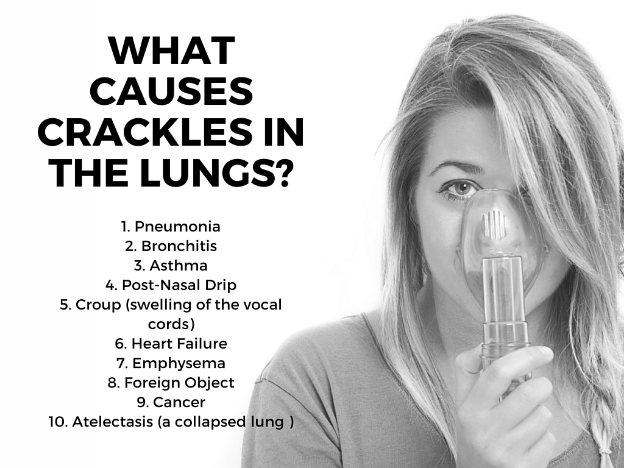

2 Many older patients with asymptomatic cardiovascular disease seem to have pulmonary crackles, even in the absence of apparent cardiac dysfunction or comorbid pulmonary disease. 1 The appearance of pulmonary crackles (rales), defined as discontinuous, interrupted, explosive respiratory sounds during inspiration, is one of the most important signs of heart failure deterioration. Heart failure is a common problem, especially in elderly patients. The occurrence of cardiopulmonary disease during follow-up included cardiovascular disease in 5 patients and pulmonary disease in 6.ĬONCLUSIONS Recognition of age-related pulmonary crackles (rales) is important because such clinically unimportant crackles are so common among elderly patients that, without knowledge of this phenomenon, their existence might interfere with the physician’s management of cardiopulmonary patients. During a mean follow-up of 11 ± 2.3 months (n = 255), the short-term (≤3 months) reproducibility of crackles was 87%.

The risk for audible crackles increased approximately threefold every 10 years after 45 years of age. METHODS After exclusion of comorbid pulmonary and other critical diseases, 274 participants, in whom the heart was structurally (based on Doppler echocardiography) and functionally (B-type natriuretic peptide <80 pg/mL) normal and the lung (X-ray evaluation) was normal, were eligible for the analysis. We examined the characteristics of pulmonary crackles among patients with stage A cardiovascular disease (American College of Cardiology/American Heart Association heart failure staging criteria), stratiffed by decade, because little is known about these issues in such patients at high risk for congestive heart failure who have no structural heart disease or acute heart failure symptoms. Always listen to instructions and follow local protocols when dealing with respiratory and airway emergencies.PURPOSE The presence of age-related pulmonary crackles (rales) might interfere with a physician’s clinical management of patients with suspected heart failure. Remember this is meant to supplement not supplant classroom instruction or protocol. If this post has been helpful to you then please like, share, and/or comment below. The airway should be monitored and EMTs and Paramedics should be prepared to maintain the airway. Stridor is common in children with Croup and epiglottis.

EMS providers should check to make sure there is no visible foreign body in the throat and if needed follow protocols for extraction. Stridor is a serious concern because it indicates an obstruction. In most cases of stridor, besides a complete history and physical examination, along with other possible additional studies, flexible or rigid endoscopy is required for an adequate evaluation of the etiology.įor further information on Stridor visit. They can also be described as unilateral or bilateral, as well as dry or moist/wet.īiphasic stridor suggests a subglottic or glottic anomaly Their presence usually indicates an airway disease, such as bronchiectasis. Coarse crackles are somewhat louder, lower in pitch, and last longer than fine crackles.The sounds from interstitial pulmonary fibrosis have been described as sounding like opening a Velcro fastener. Their presence usually indicates an interstitial process, such as pulmonary fibrosis or congestive heart failure. This sound can be simulated by rolling a strand of hair between one’s fingers near the ears, or by moistening one’s thumb and index finger and separating them near the ears. Fine crackles are soft, high-pitched, and very brief.They can also be characterized as to their timing: fine crackles are usually late-inspiratory, whereas coarse crackles are early inspiratory. Crackles are often described as fine, medium, and coarse.Crackles that do not clear after a cough may indicate pulmonary edema or fluid in the alveoli due to heart failure, pulmonary fibrosis, or acute respiratory distress syndrome.Ĭrackles that partially clear or change after coughing may indicate bronchiectasis. Crackles are much more common during the inspiratory than the expiratory phase of breathing, but they may be heard during the expiratory phase.Ĭrackles are often associated with inflammation or infection of the small bronchi, bronchioles, and alveoli. Crackles are caused by the explosive opening of small airways.


 0 kommentar(er)
0 kommentar(er)
